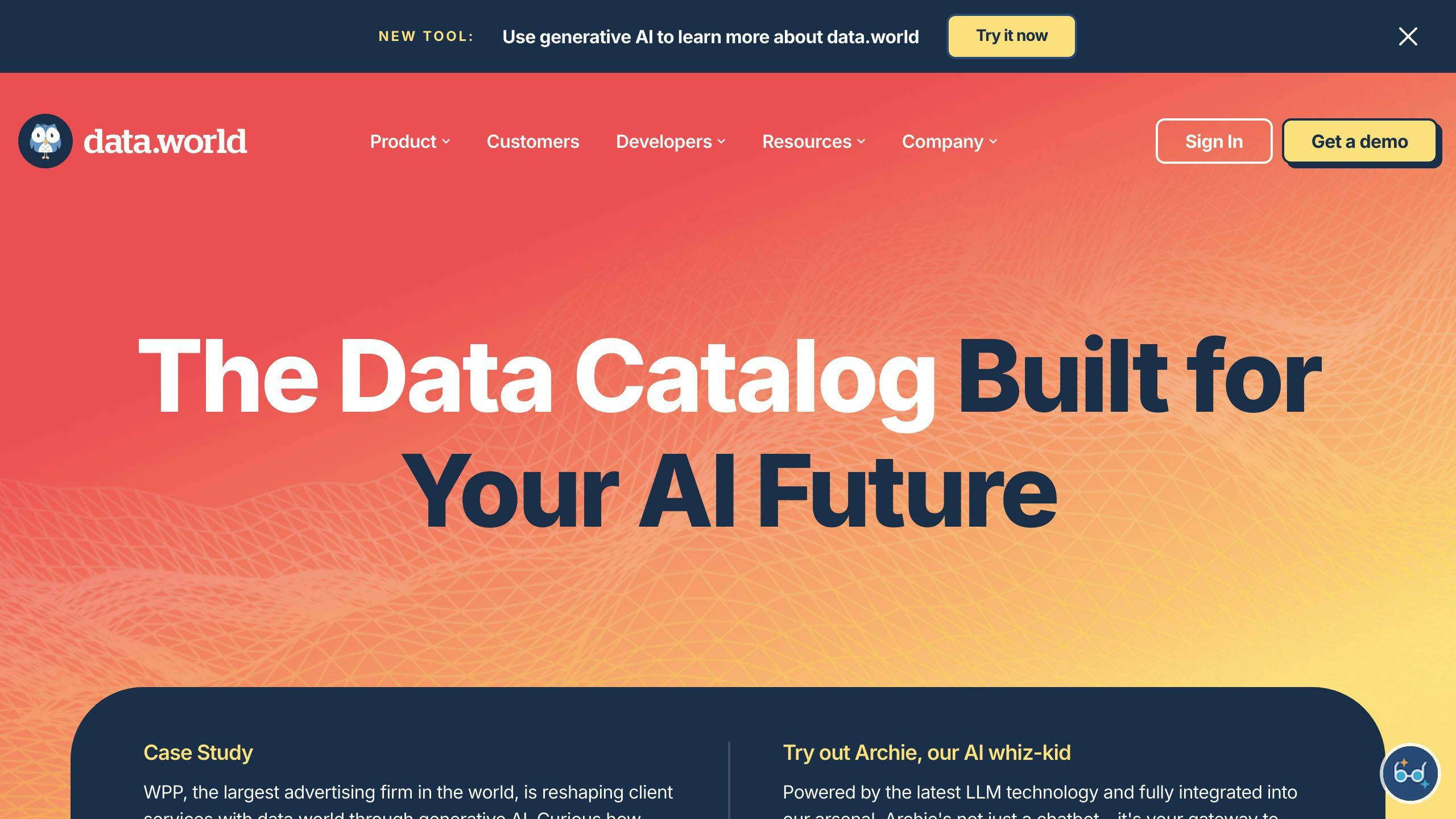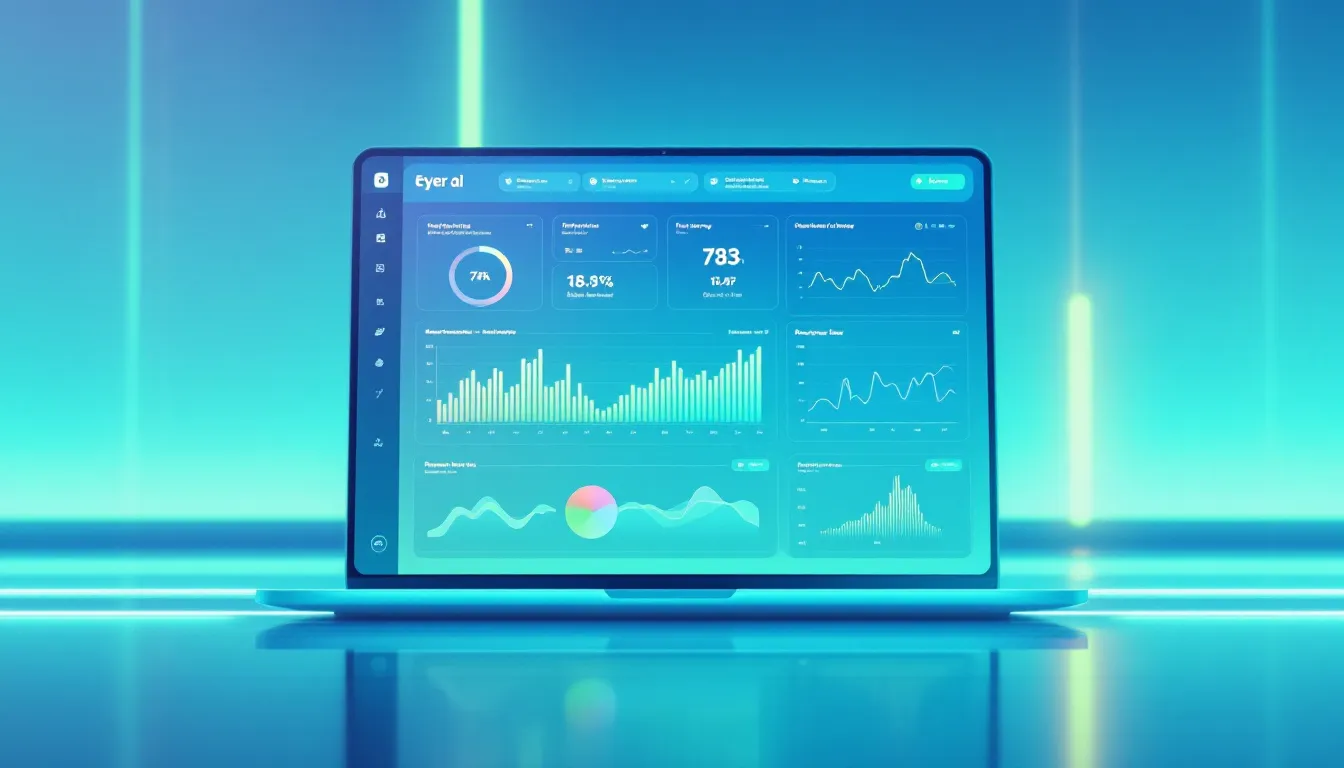Metadata governance is all about setting up the right rules and roles to manage the info that describes your data. Here's a quick breakdown of what you need to know:
- What is Metadata Governance? It's the system of rules and roles for managing the info about your data, helping everyone understand and use data better.
- Goals and Benefits: Ensures data is trustworthy, speeds up insights, and helps comply with data-related laws.
- Components: Includes standards, roles, a central repository, processes, tools, and metrics for effective management.
- Six Pillars: Centralized repository, data ownership, comprehensive documentation, insights and reporting, governance framework, and a collaborative environment.
- Implementing in Your Organization: Follow a 10-step guide to establish a solid metadata governance framework.
- Challenges and Solutions: Understand common issues like lack of understanding and integration difficulties, and strategies to overcome them.
- The Future: Looks at automation, knowledge graphs, blockchain, and cloud-native solutions as evolving aspects of metadata governance.
This guide aims to equip you with the essentials of metadata governance, why it's crucial, and how to implement and navigate challenges effectively.
What is Metadata Governance?
Metadata governance is all about making sure the information that describes your data (metadata) is well-managed. Think of metadata as the label on a food item - it tells you what's inside the package, where it comes from, and how to use it. Metadata governance sets up rules and roles to make sure this 'label' is accurate, secure, and easy for people in your company to find and use.
The main tasks include:
- Creating rules for how to describe data
- Making sure only the right people can access this information
- Helping everyone find and understand data through catalogs
- Keeping track of how data is connected
- Checking that the information about the data is complete and correct
Goals and Benefits
The main goals of metadata governance are to:
- Make sure data is trustworthy for making decisions
- Avoid mistakes in analysis due to wrong data use
- Speed up the process of getting insights from data
- Make it easier to follow data-related laws
- Protect private data from being seen by the wrong people
Other good things include:
- Easier teamwork because everyone understands the data better
- More value from data and analysis efforts
- Setting up a way to make money from data
- Making AI models more accountable and trustworthy
Role in AI-powered Platforms
Good metadata governance is crucial for AI systems to work well. It focuses on:
- Input Data Controls - making sure the data used to train AI is fair, complete, and well-described
- Model Governance - keeping track of different versions of AI models, monitoring how well they work, and making them easy to understand
- Output Data Governance - managing the data that AI creates, like scores or insights
For platforms like Eyer.ai that keep an eye on things with AI, metadata governance helps connect the dots between what the AI notices and the bigger picture. This helps make the AI smarter and helps people make better decisions based on what the AI finds.
Chapter 2: The Importance of Metadata Governance
Metadata governance is super important for making sure that the data your company uses can be trusted and is used the right way. For companies like Eyer.ai, having strong rules and practices for handling data info is key to keeping data safe, accurate, and within the law.
Ensuring Data Integrity
Metadata helps make sure that the data you're using is correct and can be traced back to where it came from. Here’s how:
- Defining data standards - Making sure everyone describes data the same way.
- Tracking lineage - Keeping an eye on where data came from and where it's going.
- Detecting data issues - Watching out for any weird changes or mistakes in the data.
- Data certification - Making sure data is good to go before using it in projects.
With good metadata, teams can trust their data more and fix problems faster.
Securing Sensitive Data
Metadata helps keep your data safe by sorting it, controlling who can see it, keeping track of who does what with it, and figuring out risks. Here’s what that includes:
- Classifying dataset sensitivity - Deciding how risky or sensitive data is.
- Controlling access - Making rules about who can see or use the data.
- Activity logging - Keeping a record of what happens with the data.
- Risk management - Using metadata to understand how safe your data is.
These steps help stop the wrong people from seeing your data while letting you know what’s going on with it.
Achieving Compliance
By keeping a close watch on how data moves and changes, metadata governance makes it easier to follow laws. This is super helpful for rules like GDPR because you can:
- Mapping data flows – Showing where personal data comes from and goes.
- Change management – Checking changes made to sensitive data.
- Right to erasure – Finding and removing personal data when needed.
With good practices in place, companies can easily show they’re handling data the right way.
In short, having good metadata practices is like having a solid foundation for your data. For companies leading the way, focusing on how to manage this info better is becoming more and more important.
Chapter 3: Components of a Successful Metadata Governance Framework
To manage metadata well, you need a few key pieces:
Standards
- Make rules for how metadata should look and work across the company.
- Decide which details are a must and which are optional.
- Set up clear naming rules and how things are connected.
Roles and Responsibilities
- Figure out who does what, like who owns the data, who keeps it in check, who makes sure it’s safe, and who checks the quality.
- Data owners decide how data should be used.
- Stewards make the rules and look after the systems.
- Security officers keep the data safe.
- Auditors check if everything’s up to mark.
Central Repository
- A single place where you can find, analyze, and understand data.
- It should let you search, connect to other systems, and get insights.
- Works with data catalogs and other storage places.
Processes
- Steps for adding, updating, and fixing metadata.
- Use tools that automatically collect metadata as data moves around.
- Keep track of changes and how to fix mistakes.
Tools
- Use automation for sorting, tracing, and managing data’s lifecycle.
- Apply machine learning to guess metadata details.
- Use APIs and data pipelines for systems to work together.
- Dashboards help find missing pieces and check quality.
Metrics
- Keep an eye on how much metadata is used, its quality, safety, and who’s in charge.
- Track how well the system covers all data.
- Spot when rules aren’t followed.
- Find ways to make things better.
With these parts in place, metadata fits snugly with your data and rules. This makes it easier to trust your data when making decisions or analyzing information.
Chapter 4: The Six Pillars of Metadata Governance
Metadata governance is all about setting up a solid system to manage all the background info about your data. It's like building a strong foundation for a house. Here are six main parts that help make this system strong and effective:
Centralized Metadata Repository
Think of this as a big, central library for all the info about your data. It helps by:
- Making it easy to find and get to this info
- Managing who can see or change the info
- Connecting with other systems like data catalogs or data lakes
- Analyzing how well the metadata system is working
Data Ownership and KPIs
- Pick people to be in charge of making sure the data info is correct and useful
- Set goals for how complete and accurate this info should be
- Keep track of progress with specific targets
- Encourage everyone to take part in keeping the data in good shape
Comprehensive Documentation
- Keep a detailed record of all the terms, categories, and data flows
- Make sure everyone uses the same terms and definitions
- Classify different types of data and how they move
- Show the path data takes from start to finish
Insights and Reporting
- Keep an eye on the health of your metadata
- Find areas that need more work and make them a priority
- Check how people are using the metadata
- Keep track of any changes or who's accessing the data to stay within the rules
Governance Framework
- Set up rules and standards for managing metadata
- Create a process for handling metadata throughout its life
- Make sure these rules are part of how data is handled every day
- Define who is responsible for what
Collaborative Environment
- Talk about metadata to make sure everyone understands it
- Manage tasks and projects related to keeping the data in order
- Alert people when something about the data changes
- Help build a culture where everyone cares about the data
By sticking to these six main parts and using the right tools and teamwork, organizations can make sure their metadata system is strong. This helps with finding data, keeping it safe, understanding its path, making sure it's good quality, and properly managing it.
Chapter 5: Implementing Metadata Governance in Your Organization
Getting your organization's metadata governance in shape is key, especially if you're dealing with sensitive info and want to make the most of your data. Here's a simple guide to get you started, plus some tips on picking the right tools.
10 Steps for Implementation
- Define goals - Figure out what you hope to achieve by managing your metadata. This could be better data quality, tighter security, or making it easier for people to use data on their own.
- Develop framework - Put together a plan that includes rules, roles, and how things should be done. Think about what kinds of data you have and how you'll keep track of it all.
- Assign roles - Decide who's in charge of what. This includes people who'll look after the data and make sure it's used right.
- Choose tools - Pick the tech tools you'll need to store, track, and manage your metadata. Make sure they work well with what you already have.
- Establish processes - Make sure there are clear steps for how metadata is created, checked, and fixed if there's a problem. Also, set rules for who can see or change it.
- Set up repository - Create a central place where all your metadata lives. This makes it easier to find and connect it to other systems.
- Classify data - Sort your data by type, like how sensitive it is or where it comes from. Decide who can access it.
- Track metrics - Keep an eye on how well you're doing with managing your metadata. Look for areas to improve.
- Provide training - Teach everyone involved what they need to know about your metadata plan and their part in it.
- Continual improvement - Keep tweaking your rules, processes, and tools based on feedback and what you learn over time.
Evaluating Tools
When picking tools for managing metadata, here's how to make a good choice:
- Figure out what you need the tool to do.
- Look at what features it offers.
- Check if the company making the tool is reliable.
- Think about costs, including buying it and getting it set up.
- Try it out with some of your data to see how it works.
- Look into what kind of help and support they offer.
Picking the right tools is super important for setting up a system that works well for your organization.
sbb-itb-9890dba
Chapter 6: Overcoming Metadata Governance Challenges
When trying to manage all the background info about your data well, you might hit some bumps in the road. Knowing what these problems are and how to deal with them can keep things moving smoothly.
Lack of Understanding
Not everyone gets why keeping track of data info is important, which can make it hard to get their support.
Strategies:
- Teach them with training sessions
- Help them see the big picture in group discussions
- Show how it helps reach business goals
Standardization Issues
It's tough to make one set of rules that fits everything, especially when you have lots of different systems.
Approaches:
- Work together to make a common set of terms
- Find a good middle ground between being flexible and consistent
- Start with the most important areas first
Integration Difficulties
Linking all your systems together can get tricky.
Solutions:
- Use special connectors and online tools for them to work together
- Make sure your data can grow and change easily
- Check everything works well before fully using it
Privacy Concerns
With strict rules about data, keeping it safe, especially the sensitive stuff, is key.
Safeguards:
- Sort data by how sensitive it is and protect it accordingly
- Set up who can see what
- Keep checking and adjusting as you go
Stakeholder Engagement
Getting everyone on board and keeping them interested is hard.
Tactics:
- Make it fun or rewarding to take part
- Connect successes back to their goals
- Encourage a data-friendly culture from the top down
Scalability Problems
Your system needs to be able to handle more data and more users over time.
Scalable Architectures:
- Use cloud services to grow
- Spread out data storage
- Split data into chunks
- Automate as much as you can
With a good plan for tackling these issues, managing your data's background info can really pay off.
Chapter 7: Case Studies and Best Practices
Data.World

Data.world tackled the challenge of organizing 500 million rows of survey data by putting in place data stewards and governance rules. This helped make their huge amount of data more organized and trustworthy.
- They had big problems with keeping their data consistent and reliable because it came from many different places.
- They introduced specific people (data stewards) to look after different types of data.
- They made rules for how data should be organized, who can see it, and how it should be tagged.
- They set up automatic systems to handle how data is brought in and tracked.
- This led to better, more reliable data that people could use to make decisions.
By getting a handle on their metadata, data.world made it easier for users to find and trust the data they needed.
F1000 Research Publishing Platform
F1000 set up a system to check the details of research articles before publishing them. This was to make sure the research met high standards.
- They needed a way to check that authors were who they said they were and that their research was legit.
- They brought in a system that required detailed information about the research methods, any potential conflicts of interest, and where the data came from.
- They automated checks to make sure submissions followed their rules.
- This made it easier for reviewers to understand the research and check it properly.
- They kept up high standards for the quality and reliability of the research they published.
F1000's approach to managing metadata helped make sure the research they shared was trustworthy and clear.
Chapter 8: The Future of Metadata Governance
Metadata governance is changing quickly because of new tools that help us manage and understand data better. Let's look at some key trends that might change how we handle metadata in the future.
Automation
Tools like AI and machine learning are starting to do a lot of the work for us, including:
- Auto-classification - These smart tools can look at data and figure out what category it belongs to or how sensitive it is. This makes things faster and more consistent.
- Relationship inference - They can also find how different pieces of data are connected, which helps us understand data's journey better.
- Anomaly detection - If something unusual happens with our data, these tools can spot it quickly, helping us keep an eye on things.
Automation means we can manage data more smartly and on a bigger scale without getting bogged down in details.
Knowledge Graphs
Knowledge graphs link data and metadata in a way that shows how everything is connected. They're great because they:
- Contextual clarity - Make it easier to see what metadata means and how it's connected to other data.
- Enhanced analysis - Let us do deeper analysis, like seeing the full path data takes.
- Reusability - Help us use the same metadata setups for different data projects.
Knowledge graphs give us a flexible way to keep improving how we manage metadata.
Blockchain
Blockchain is a secure way to keep track of metadata changes. It's useful for:
- Provenance trails - Keeping a secure record of when data is accessed, changed, or deleted. This helps us trust our data more.
- Smart contracts - Setting up rules for how metadata should be used and making sure those rules are followed automatically.
Blockchain is still new for metadata, but it could make our data much more secure and trustworthy.
Cloud-Native
Using cloud platforms helps us handle metadata better because:
- Metadata fabrics - These are like central hubs in the cloud where all our metadata comes together.
- APIs and microservices - These tools help us access and use metadata easily across different systems.
- Serverless options - Cloud services can take care of tasks like tagging data, saving us time and effort.
As we get more data, cloud platforms can help us manage metadata more effectively.
With data getting more complex, having a good grip on metadata is more important than ever. Luckily, new technologies are making it easier to manage data well, ensuring it's accurate and useful. While trying new technologies can be risky, the future of managing metadata looks promising.
Conclusion
Metadata governance is super important for making sure our data is in good shape and safe, especially for companies like Eyer.ai that handle a lot of info. As we deal with more and more data, having a solid plan for our metadata helps us use this data wisely and keeps us out of trouble.
Here's a quick look at the main benefits metadata governance gives us:
- Enables Trust in Data - When metadata is clear and complete, it helps everyone understand what the data is about and where it came from. This makes people more confident in using the data for big decisions and for running AI models.
- Speeds Up Discovery - Good metadata makes it easier to find the data you need by searching or looking through data catalogs. This means you can get to the insights you want faster.
- Improves Data Quality - Having rules and steps in place makes sure metadata is consistent and accurate. There's also a way to check if the data is good to use.
- Manages Risk - By knowing which data is sensitive and who can access it, and by keeping an eye on changes, we can protect our data from problems.
- Achieves Compliance - Keeping track of how data moves and changes helps us follow laws about keeping data private and secure.
For a company like Eyer.ai, taking good care of metadata means they can quickly figure out where their AI's insights are coming from. It also helps them manage AI models that use sensitive data responsibly.
As companies aim to build strong data systems with the latest tech like AI, focusing on metadata governance is the first step. It helps make sure our data systems can grow, are secure, and follow the rules. Plus, it builds trust by making sure we can use our data to its fullest potential.
Related Questions
What are the 4 essential components of data governance?
The 4 key parts you really need to know about when it comes to managing data well are:
- Data quality - Making sure data is right, matches up, and you can count on it
- Data stewardship - Having specific people look after how data is used and kept healthy
- Data protection & compliance - Keeping data safe and following the rules
- Data management - Setting up steps for how to collect, store, mix, and analyze data
These parts work together to make sure you can trust your data while keeping it safe.
What are the 5 principles of data governance?
The main rules that make managing data work well are:
- Integrity - Data is correct, matches up, and reliable
- Security - Data is well-protected
- Transparency - It's clear who changes or looks at data
- Compliance - Handling data the right way according to laws
- Quality - Data meets the mark for being complete, valid, and consistent
Following these rules helps make sure using data for decisions is a good idea.
What is metadata governance?
Metadata governance is all about taking care of the info that describes other data (metadata). It sets up who's responsible, the rules, and how to handle creating, checking the quality, controlling who can see it, and using metadata in your workplace. When metadata is well-managed, it makes it easier to understand, find, and use the main data properly.
What are 5 areas of data governance?
The 5 main focus areas are:
- People - The folks who own, look after, and use data
- Strategy - The plan, rules, and goals for data
- Processes - The way data is handled day-to-day
- Regulations - Making sure data use follows security and privacy laws
- Technology - The tools and systems that make managing data possible
When these areas are in sync, data is handled well and can help the organization succeed.



